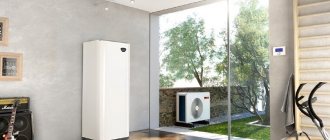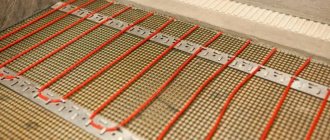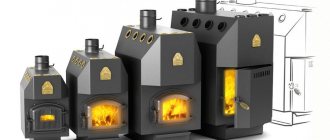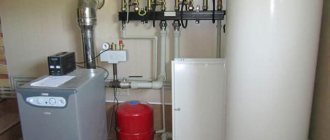With the rise in price of natural resources used for lighting and heating a home, it is increasingly necessary to look for a replacement for them - alternative sources are appearing. One such option for heating houses is solar collectors.
Their work is based on absorbing solar radiation and converting it into heat. Using them in summer in clear weather is understandable. Let’s try to figure it out together how a solar collector works in winter.
Types of collectors
Two types of batteries are especially popular: flat plate and vacuum.
Flat plate collector
The device consists of a plate (absorber) that captures radiation, a transparent coating that transmits light, and a heat-insulating layer. The front part of the plate is covered with black paint, because the dark color attracts the rays of the sun better. It can also be a special coating - for example, titanium oxide or black nickel. The most productive absorbers are made of copper.
The transparent coating is made from polycarbonate, smooth or grooved, or from reinforced glass, which has a very low metal content.
Thermal insulation consists of tubes made of copper or cross-linked polyethylene. The coolant spreads through them. A vacuum is created inside the panel to prevent heat loss. If heat is not removed, the storage water can be heated to a temperature of 190–210 degrees.
Vacuum manifolds
The tube of this device through which the coolant flows is an absorber. It is placed in a vacuum vessel made of transparent tempered glass.
This model is more expensive than a plate device, but it is more productive. Here you can heat the water up to 250–300 degrees.
What can a solar system be made from?
First, you need to understand what operating principle a solar water heater uses. The internal structure of the block contains the following components:
- frame;
- absorber;
- a heat exchanger within which the coolant will circulate;
- reflectors to focus the sun's rays.
The factory solar water heating collector works as follows:
- Heat absorption - the sun's rays pass through the glass located on top of the body or through vacuum tubes. The internal absorbent layer in contact with the heat exchanger is painted with selective paint. When sunlight hits the absorber, a large amount of heat is released, which is collected and used to heat water.
- Heat transfer - the absorber is located in close contact with the heat exchanger. The heat accumulated by the absorber and transferred to the heat exchanger heats the liquid moving through the tubes to the coil inside the heat storage tank. Water circulation in the water heater is carried out by forced or natural means.
- DHW - two principles of heating hot water are used:
- Direct heating - hot water after heating is simply discharged into a thermally insulated container. In a monoblock solar system, ordinary household water is used as a coolant.
- The second option is to provide domestic hot water with a passive water heater based on the principle of indirect heating. The coolant (often antifreeze) is sent under pressure to the solar collector heat exchanger. After heating, the heated liquid is supplied to a storage tank, inside of which a coil (playing the role of a heating element) is built, surrounded by water for the hot water supply system. The coolant heats up the coil, thereby transferring heat to the water in the container. When the tap is opened, heated water from the heat-storing tank flows to the water collection point. The peculiarity of a solar system with indirect heating is its ability to operate throughout the year.
The operating principle used in expensive factory-made solar systems is copied and repeated in do-it-yourself collectors.
The working designs of solar water heaters have a similar structure. They are only made from scrap materials. There are schemes for the production of collectors from:
- polycarbonate;
- vacuum tubes;
- PET bottles;
- beer cans;
- refrigerator radiator;
- copper tubes;
- HDPE and PVC pipes.
Judging by the diagrams, modern “Kulibins” prefer homemade systems with natural circulation, thermosiphon type. The peculiarity of the solution is that the storage tank is located at the top point of the hot water supply system. Water circulates through the system by gravity and is supplied to the consumer.
Polycarbonate manifold
To make a solar system yourself, in particular a homemade solar water heater made of polycarbonate, you will need the following materials:
- two threaded rods;
- propylene corners, the fittings must have an external threaded connection;
- PVC plastic pipes: 2 pcs, length 1.5 m, diameter 32;
- 2 plugs.
The pipes are laid parallel to the housing. Connect to the hot water supply via shut-off valves. A thin cut is made along the pipe into which a sheet of polycarbonate can be inserted. Thanks to the thermosiphon principle, water will independently flow into the grooves (cells) of the sheet, heat up and go into the storage tank located at the top of the entire heating system. To seal and fix the sheets inserted into the pipe, thermally resistant silicone is used.
To increase the thermal efficiency of a cellular polycarbonate collector, the sheet is coated with any selective paint. Heating of water after applying selective coating accelerates approximately twice.
Vacuum tube manifold
In this case, it will not be possible to get by solely with improvised means. To make a solar collector you will have to buy vacuum tubes. They are sold by companies involved in the maintenance of solar systems and directly by manufacturers of solar water heaters.
For independent production, it is better to choose flasks with feather rods and a heat-pipe thermal channel. The tubes are easier to install and change if necessary.
You also need to purchase a concentrator block for a vacuum solar collector. When choosing, pay attention to the performance of the node (determined by the number of handsets that can be simultaneously connected to the device). The frame is made independently by assembling a wooden frame. Savings when manufacturing at home, taking into account the purchase of ready-made vacuum tubes, will be at least 50%.
Solar system made from plastic bottles
To prepare you will need about 30 pcs. PET bottles. When assembling, it is more convenient to use containers of the same size, 1 or 1.5 liters. At the preparatory stage, the labels are removed from the bottles and the surface is thoroughly washed. In addition to plastic containers, you will need the following:
- 12 m of hose for watering plants, diameter 20 mm;
- 8 T-adapters;
- 2 knees;
- roll of Teflon film;
- 2 ball valves.
When making solar collectors from plastic bottles, a hole is made at the bottom of the base equal to the diameter of the neck, into which a rubber hose or PVC pipe is inserted. The collector is assembled in 5 rows of 6 bottles on each line.
On a clear day, within 15 minutes. the water will heat up to a temperature of 45°C. Considering the high performance, it makes sense to connect a solar water heater made from plastic bottles to a storage tank of 200 liters. The latter is well insulated to prevent heat loss.
Aluminum beer can collector
Aluminum has good thermal characteristics. It is not surprising that metal is used to make heating radiators.
Aluminum cans can be used in the manufacture of homemade solar systems. Cans made of tin or any other metal are not suitable for production.
For one solar panel the following components will be needed:
- jars, about 15 pcs. per line, the body accommodates 10-15 rows;
- heat exchanger - a collector made of a rubber hose or plastic pipes is used;
- glue for gluing cans together;
- selective paint.
The surface of the cans is painted dark. The box is covered with thick glass or polycarbonate.
A solar collector made of aluminum cans is often made for air heating. When using water coolant, the thermal efficiency of the device decreases.
Solar system from the refrigerator
Another popular solution that requires minimal time and money. The solar collector is made from the radiator of an old refrigerator. The coil is already painted black. It is enough just to place the grille in a wooden case with insulation and connect it to the hot water supply using soldering.
There is an option for making an air conditioner from a condenser. To do this, several radiators are connected into a single network. If it is possible to purchase cheaply about 8 pcs. capacitors, manufacturing a collector is quite possible.
Copper tube collector
Copper has good thermal properties. In the manufacture of a copper solar collector, the following is used:
- pipes with a diameter of 1 1/4″, used in the installation of heating and hot water supply systems;
- 1/4″ pipes used in air conditioning systems;
- gas-burner;
- solder and flux.
The radiator grille body is assembled from copper pipes with a large diameter. Holes equal to 1/4″ are drilled into the surface. Pipes of the appropriate diameter are inserted into the resulting grooves. The radiator is covered with glass or polycarbonate. Copper is painted with selective paint.
Solar boiler made of HDPE pipes and PVC hoses
In the production of solar systems, almost any available material is used. There are solutions that allow you to make a collector from corrugated hose, a rubber hose used for watering plants.
It is possible to manufacture a solar collector from corrugated stainless pipe. The popularity of the solution is due to the speed and ease of installation. Corrugated stainless steel pipe is laid in rings or snakes. The disadvantage is the relative high cost of stainless corrugated pipe.
Making a solar hot water collector from PEX pipe:
All the pipes described are used with varying efficiency as a core in the manufacture of a homemade solar collector from plastic bottles and aluminum cans.
Applications of collectors
Despite the high cost, the use of solar systems is very popular both in industry and in everyday life.
Owners of solar systems use solar collectors not only for heating their houses. They work fruitfully for heating water in showers and heating swimming pools.
For production purposes, the use of these devices is more common. They are used to heat hotels and restaurants. Steam generators operating on the principle of solar panels drive various units. Water desalinators are also made on the basis of solar systems.
Summarizing
Taking into account the efficiency of solar collectors, it becomes clear that heating a house only using them will be expensive compared to other methods of heating a home. Heating using inverter air conditioners, such as heat pumps, which are capable of pumping about 5 kilowatts of heat into the building for every kilowatt of power will be more profitable.
The sources of energy for them are soil, outdoor air and water from never-freezing reservoirs. You can use a solar collector as a heating equipment in the absence of a main gas supply.
Performance of solar systems in winter
No one doubts the use of ecosystems in summer. But how solar panels work in winter remains a sore point among users.
It is safe to say that solar collectors work in winter. Of course, their efficiency decreases and an additional heating source is required. After all, in winter the sun also shines clearly, and on cloudy days the absorber collects reflected sunlight passing through the clouds.
The performance of the battery also depends on its angle of inclination relative to the horizon. It is set to make the most of the light during the short winter day.
Snowfalls significantly impair the operation of the collector, so cleaning it from snow accumulation is the main condition for operation in winter. Snow is the enemy of a flat device. Vacuum batteries tend to heat the entire flask and self-clean. But sometimes they have to be cleaned forcibly.
Preservation of a seasonal solar collector
In April 2021, I purchased a 125 liter pressureless solar water heater from you. My friend and I installed a bathhouse on the roof of the SNT “Tebenki” in the Solnechnogorsk district of the Moscow region (Sokolovo settlement).
Water was supplied from the house water supply through a filter under pressure up to 3 atm. The pipes are polypropylene, I bought a separate electric soldering iron for polypropylene pipes. I soldered it myself, nothing complicated. A shower cabin was installed inside the bathhouse. I installed a sink on the outside and also left a drain tap for hot water (from there I get hot water for the children's pool).
Very convenient, every day throughout the summer 125 l. boiling water!!!!
In order not to disassemble the vacuum tubes when preserving for the winter, I remade the frame (shortened two rear posts and attached hinges to them, secured the other end of the hinges to a construction “U” shaped profile for dry plaster (bought 2 pieces separately in a hardware store, bent them at the angle of the ridge roof, secured to the roof with bolts for corrugated sheets).
On the ridge of the bathhouse roof, I installed an “American” coupling on the hot and cold water pipes. When storing for the winter, I disconnect these couplings and carefully lift the frame from the front until the tubes tilt towards the tank and lower it back to drain the water from the tubes.
I repeat this procedure several times until water stops flowing from the coupling (it’s difficult for one, an assistant is needed, because each tube contains almost 3 liters of water, and there are 15 of them).
When adjusting the temperature at the outlet of the shower and sink, I had to close the cold water tap more due to the pressure difference, because... cold water enters under a pressure of 3 atm, and hot water flows by gravity.
During a consultation in the office, it was recommended to install a pressure reducer to 0.5-1.0 atm at the entrance of the shower and sink. During operation, a problem arose with the solenoid valve; it did not close completely when filling with water. Replaced under warranty without any problems on the same day.
I recommend it to anyone who has a dacha or summer home! I am very glad. The staff is very friendly. Sales manager Viktor Vladislavovich Tukalo worked with me. Thank him very much.
Ildar Shaikhutdinov.
Photo1. Solar collector at the dacha in SNT Tebenki, Solnechnogorsk district, Moscow region (Sokolovo settlement).
Photo 2. The solar collector is mounted on the roof of the bathhouse.
Photo 3. Solar collector controller.
Photo. 4 Water supply to the solar collector.
Photo 5. Water supply to the solar collector.
Photo 6. Water supply to the solar collector.
A rotating frame for quickly draining water from the tubes when preserving the solar collector (now you don’t have to remove each tube from the tank, but tilt the entire structure at once and drain the water).
Photo 7. Solar collector frame.
Photo 8. Rotating frame of the solar collector.
Photo 9. Rotating frame of the solar collector.
Advantages and disadvantages of the collector
The main advantage of a solar system is environmental friendliness.
- When generating heat in solar panels, no harmful substances are formed. It is absolutely harmless to both humans and nature.
- Very economical installation. The costs of purchasing and installing the system are recovered over several years. In subsequent years, the battery only works as a plus, saving costs on heating the room and heating water.
- Use the system all year round. In winter, the sun does not shine so brightly, but even through the clouds up to 75% of solar radiation reaches us, which makes it possible to use the solar system at any time of the year. Despite the fact that in winter the operating efficiency decreases, the installation produces up to 50% of the required energy.
The only drawback of the collector is its high cost. Not everyone can afford such luxury.
How to make selective coating
A highly efficient collector has a high degree of solar energy absorption. The rays hit a dark surface and then heat it up. The less radiation is repelled from the solar collector absorber, the more heat remains in the solar system.
To ensure sufficient heat accumulation, it is necessary to create a selective coating. There are several production options:
- Homemade selective collector coating - use any black paints that leave a matte surface after drying. There are solutions when an opaque dark oilcloth is used as a collector absorber. Black enamel is applied to the heat exchanger pipes, the surface of cans and bottles, with a matte effect.
- Special absorbent coatings - you can go the other way by purchasing a special selective paint for the collector. Selective paints and varnishes contain polymer plasticizers and additives that provide good adhesion, heat resistance and a high degree of absorption of sunlight.
Solar systems used exclusively for heating water in summer can easily get by by painting the absorber black using regular paint. Homemade solar collectors for heating a house in winter must have a high-quality selective coating. You can't skimp on paint.
Homemade or factory solar system - which is better?
It is unrealistic to make a solar collector at home that can be compared with factory products in terms of technical characteristics and performance. On the other hand, if you simply need to provide enough water for a summer shower, solar energy will be enough to operate a simple homemade water heater.
As for liquid collectors operating in winter, not even all factory solar systems can operate at low temperatures. All-season systems are most often devices with vacuum heat pipes, with increased efficiency, capable of operating at temperatures down to –50°C.
Factory solar collectors are often equipped with a rotating mechanism that automatically adjusts the angle of inclination and direction of the panel to the cardinal points, depending on the location of the Sun.
An effective solar water heater is one that fully meets its intended purpose. To heat water for 2-3 people in the summer, you can get by with an ordinary solar collector, made with your own hands from improvised materials. For heating in winter, despite the initial costs, it is better to install a factory solar system.
Video course on making a panel solar water heater
Recently, alternative energy sources have attracted increasing interest from our compatriots.
The simplest of them in design are solar collectors, due to which their share in non-traditional energy, especially household energy, is extremely large.
This article will introduce the reader to their varieties, and will also help to find the answer to the question: how effective is a solar collector in winter?










